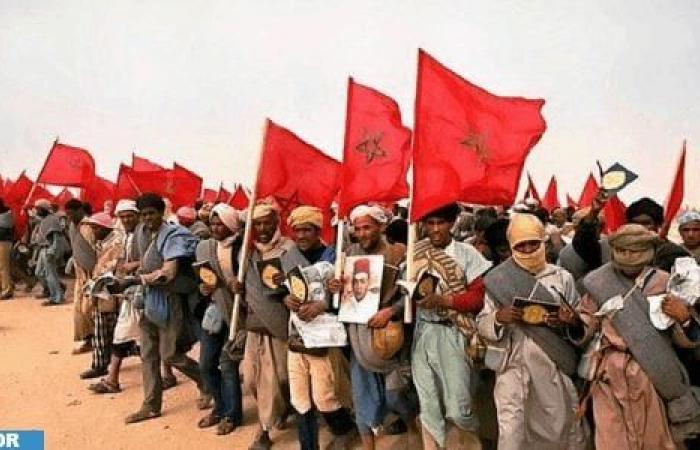
Monday, November 4, 2024 – 13:21
Rabat – The Moroccan people will celebrate, tomorrow, Wednesday, the 49th anniversary of the victorious Green March, which, as a historical epic, embodied the most wonderful images of cohesion between the honorable Alawite throne and the loyal Moroccan people in order to complete national independence and achieve sacred territorial unity.
The High Commission for the Veterans of Resistance and Members of the Liberation Army stated, in a statement, that “with all manifestations of pride and honor, and in an atmosphere of overflowing national enthusiasm, continuous mobilization and constant vigilance around our first national cause, the issue of sacred territorial unity, the Moroccan people, along with the family of the resistance and the Liberation Army, commemorate on Wednesday.” November 6, 2024, from Tangier to Lagouira, one of the most precious and cherished glorious national memories in the process of completing national independence and achieving territorial unity.”
The delegation highlighted, “It is the 49th anniversary of the victorious Green March, which was created by the genius of the unified King, His Majesty the late Hassan II, may God rest his soul, and in which masses of volunteers from all groups and segments of Moroccan society, and from all parts of the country, set out on this day in the year 1975, with order and regularity.” In one direction, towards the Moroccan Sahrawi regions to liberate them from the clutches of Spanish colonialism, with the strength of faith and in a unique, peaceful, civilized manner, he demonstrated to the whole world the steadfastness of Moroccans and their firm will to regain their stolen right, and their resolve and insistence on ending the foreign presence and colonial domination, with their cohesion and cohesion, top and bottom.”
The victorious Green March has achieved its goals and destroyed the artificial borders between the people of one nation. Its weapon is the Book of God, defending the nation’s fever and hostility, and adhering to virtue and the values of peace and peace in reclaiming and defending the stolen right.
Thus, the Green March demonstrated to the entire world, with argument and proof, the extent of cohesion embodied by the genius of a Mujahid king, the magnanimity of a loyal people, and the determination of all Moroccans from the far south to the far north to complete their national independence and achieve their territorial unity, and that their weapon in doing so was their belief in the justice of their cause and their recruitment and mobilization to defend their sanctities. Religious principles, their national constants, and the defense of the possession of sacred national territory.
She added that Morocco made great sacrifices in the face of the foreign occupation that weighed heavily on the national territory for nearly half a century, and divided the country into areas of influence distributed between the French protectorate in central Morocco, the Spanish protectorate in its north, and colonial influence on its southern regions, while the Tangier region was subject to an international system of government.
The throne and the people made great and wonderful sacrifices in the midst of an ongoing national struggle to achieve freedom, independence, unity, and salvation from the yoke of colonialism, until the clear victory and the desired goal were achieved with the victory of legitimacy and historical legitimacy and the return of the hero of liberation and independence and the first resistance, His Majesty the late Mohammed V, and the honorable royal family from exile to… The land of the homeland, triumphantly on November 16, 1955, carrying the banner of freedom, independence and national sovereignty, calling on God to have mercy on him to continue the smaller jihad with the greater jihad in order to build and raise the edifices of the new, rising and advanced Morocco.
The end of the era of quarantine and protection was only the beginning of the epic of the greatest economic and social jihad and the uplifting of the nation’s edifices, the first of which was to liberate what remained of the Kingdom’s soil from the yoke of occupation. In this context, the operations of the Liberation Army in the southern provinces were launched in 1956 to complete national independence and liberate the usurped parts of the national territory. The liberation march continued under the leadership of the hero of liberation and independence and the first resistance, His Majesty the late Muhammad V, may God be pleased with him, with strong determination and a solid will to achieve the recovery of the Tarfaya region in April 15, 1958.
During the reign of His Majesty the late Hassan II, may God rest his soul, the Kingdom continued its struggle to reclaim the city of Sidi Ifni (June 30, 1969), and culminated in the great historical march (November 6, 1975), which embodied the genius of the unified king who was able, in a peaceful and unique civilizational style, to emerge from the power of belief in truth. With the justice of the national cause, the southern provinces were restored, and victory was for the Moroccans, and the flag of the homeland rose fluttering in the sky of Laayoune on February 28, 1976, marking the end of the period of occupation and foreign presence in the Moroccan Sahara, followed by the recovery of the Oued Eddahab region on August 14, 1979.
The saga of maintaining the territorial integrity continued, with all faith, determination and determination, to thwart the maneuvers of the territorial integrity’s opponents. And here is Morocco today, under the leadership of the instigator of the Moroccan renaissance, His Majesty King Mohammed VI, may God assist him, standing steadfast and steadfast in defending its legitimate rights, highlighting with complete consensus its determination to preserve its territorial integrity, and confirming to the whole world, through its wise and insightful positions, its strong will and continuous militancy in defense of… The Moroccanity of his Sahara, and his serious initiative to end the regional conflict that has been created in the Maghreb region, which has been prolonged as a result of the intransigence and obstinacy of the opponents of the territorial integrity and those opposed to Morocco’s established rights over its reclaimed lands.
The delegation highlighted that “the resistance family and the Liberation Army, while proudly recalling this historical epic rich in lessons and lessons and full of connotations, meanings and values, renew its firm position on the issue of our territorial integrity by emphasizing the Moroccanity of the Sahara, and declaring its stand against the maneuvers of the opponents of our territorial integrity and the plans of those lurking for Morocco’s sovereignty over the entirety of it.” Its sacred soil, on which there is no concession or compromise in an inch of it, and the continuous mobilization and continuous recruitment of all groups and segments of society, the living forces and the Moroccan people as a whole, behind His Majesty King Mohammed VI, may God protect him, in order to plead our first national cause, the issue of territorial unity.”
And to celebrate this glorious historical event with the appropriate manifestations of pride and dignity, and to highlight its symbolic connotations and noble values, and to spread the positions of true patriotism, positive citizenship, and civil behavior among emerging, youth, and new generations, the High Commission for the Veterans of Resistance and Members of the Liberation Army will organize, the day after tomorrow, Wednesday, in the National Space for the Historical Memory of the Resistance. And its affiliate Tahrir in Rabat will host a speech festival and an intellectual symposium during which speeches, presentations and testimonies will be given about this historical event.
By the way, an elite group of veteran resistance fighters and members of the Liberation Army will be honored, in keeping with the established tradition, and in order to consolidate the praiseworthy Sunnah, with gratitude and appreciation for this benevolent elite who were loyal to the homeland, gave, supported, and sacrificed in defense of its freedom, independence, and territorial integrity.
The delegation will also organize, next Saturday, in Tarfaya and Laayoune, two speech festivals and two communication meetings during which speeches and testimonies will be given to praise the chapters of this heroic epic and highlight its distinguished place in our national history, filled with the masterpieces of struggles for freedom, independence, national sovereignty, completion of territorial unity, and honoring the elite of the ancient resistance fighters. And members of the Liberation Army and distributing financial aid to a number of members of this family who deserve continuous care and care.
The delegation indicated that activities and events will be held in all regions, prefectures and regions of the Kingdom on this occasion, which will be supervised by the regional and regional prosecutors, local offices and spaces of historical memory of resistance and liberation, including seminars and lectures, including the presentation of the High Commission’s publications for the veterans of the resistance and members of the Liberation Army, as well as organizing visits for the benefit of age groups. Regardless of their diversity, the historical memory spaces of resistance and liberation number 104 units-spaces, open throughout the national territory.





